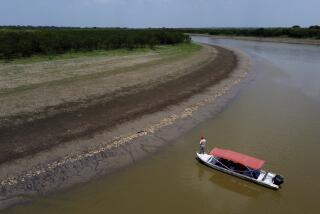Yangtze dolphin extinct, experts say
BEIJING — After a fruitless six-week expedition up and down the Yangtze River, an international team of scientists concluded Wednesday that the baiji, a freshwater dolphin that was one of the world’s oldest species, is almost certainly extinct.
The researchers said they believed that it was the first time that a large-mammal species had been wiped out primarily by human-led destruction of its habitat, and they warned that another species, the Yangtze finless porpoise, appeared headed for the same fate.
The expedition, led by China’s Agriculture Ministry and organized by the baiji.org Foundation and the Wuhan Institute of Hydrobiology, said the dolphins were killed by a combination of overfishing, habitat loss and collisions with ships. The last two factors reflect the increasing industrial development along the river.
“The Yangtze is not a natural habitat anymore for cetaceans,” said August Pfluger, a Swiss economist and environmental activist who helped organize the expedition. “The natural habitat that the baiji would use, it’s not there anymore.”
Pfluger said large parts of the river had been turned into concrete channels, and sandbars that were an important part of the dolphin’s habitat had largely been destroyed.
The baiji, a beloved creature known as “the goddess of the Yangtze,” was believed to date back 20 million years and was once a common sight as it cavorted in the river. As recently as the 1980s, scientists counted about 400 of the dolphins.
The six-nation team of scientists that conducted the latest survey said it was possible, if unlikely, that it had missed one or two animals, but that the species could be considered “functionally extinct.” Any remaining dolphins would have no chance of survival, the researchers said.
The scientists said it did not appear that pollution was a culprit. “The river is highly polluted, but ... it’s not a toxically polluted river,” Pfluger said.
The Yangtze, the longest river in Asia and third-longest in the world, is a vital source of water and electricity. Its basin is home to 400 million people.
Using two research vessels, the baiji expedition surveyed the river along a 2,200-mile stretch from near the Three Gorges Dam to the Yangtze’s mouth at Shanghai, China’s largest city.
The researchers also made a tally of the finless porpoise. They counted 400, a dramatic decline from a population of about 5,000 in the 1980s.
Wang Ding, deputy director of the Wuhan Institute of Hydrobiology, was quoted as saying on baiji.com, “If we do not act soon, they will become a second baiji.”
*
More to Read
Sign up for Essential California
The most important California stories and recommendations in your inbox every morning.
You may occasionally receive promotional content from the Los Angeles Times.










